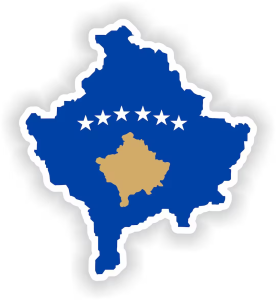Everything You Need To Know For Kosovo
Geographical Position And Climate Of Kosovo
Kosovo is located in Southeastern Europe, in the central region of the Balkan Peninsula. It is landlocked and bordered by Serbia to the north and east, North Macedonia to the south, Albania to the west, and Montenegro to the northwest. The capital city of Kosovo is Pristina.
Due to its varied topography, climate conditions can differ significantly from one area to another within Kosovo. The lowlands have warmer summers and colder winters compared to the hilly and mountainous regions which have milder summers and harsher winters.
Brief History Of Kosovo
Kosovo, a region in the Balkan Peninsula, has seen extensive historical fluctuations in sovereignty and ethnic tensions. Its history traces back to the ancient Dardanian kingdom before becoming a part of the Roman Empire.
In the Middle Ages, it was important within the Serbian Empire but fell under Ottoman rule in the late 14th century. This period saw an influx of Albanians, altering the demographic composition. After World War I, Kosovo became a part of the Kingdom of Serbs, Croats, and Slovenes, known later as Yugoslavia.
Following the breakup of Yugoslavia in the 1990s, Kosovo’s predominantly ethnic Albanian population sought independence from Serbia. Tensions escalated, leading to the Kosovo War in 1998-1999, which ended with NATO intervention and Kosovo being placed under United Nations administration.
On February 17, 2008, Kosovo declared independence from Serbia. While over 100 countries have recognized Kosovo, it remains a partially recognized state due to ongoing disputes, particularly with Serbia and countries that do not recognize its sovereignty.
Religion
The majority of Kosovo’s population is Muslim. There are Orthodox and Roman Catholic minorities.
Language
The official languages of the country are Albanian and Serbian. Bosnian and Turkish are spoken in places.

Kosovo, Europe’s youngest country, is a hidden gem for travelers seeking off-the-beaten-path experiences. Its tourism sector is growing, offering a blend of historical sites, natural beauty, and vibrant culture.
Places You Must Visit In Kosovo
Before You Visit Kosovo
Travel to Kosovo
Traveling to Kosovo is relatively straightforward, with several options available for international visitors:
By Air: The main entry point by air is through Pristina International Airport (Adem Jashari), which offers flights to and from numerous European cities. Airlines such as Eurowings, Swiss International Air Lines, and Turkish Airlines provide regular services.
By Road: Kosovo is accessible by road from neighboring countries. You can enter via Serbia, Montenegro, Albania, North Macedonia, or through the UNMIK-administered boundary with Serbia. Ensure you have the necessary documentation for border crossings.
By Bus: There are frequent international bus services connecting Kosovo with Germany, Switzerland, Belgium, Turkey, Albania, North Macedonia, and Serbia. Buses are an affordable option, though travel times can be long.
By Train: While train services are limited, there is a line that connects Kosovo to North Macedonia, with onward connections to other parts of Europe.
Visas for Kosovo
Kosovo has a relatively liberal visa policy, allowing many travelers to visit without a visa for short stays:
Visa-Free: Nationals from the EU, the US, Canada, Australia, New Zealand, and many other countries can enter Kosovo visa-free for up to 90 days within a 180-day period.
Visa on Arrival: For some nationalities, a visa on arrival can be obtained at the Pristina International Airport or at land border crossings. It’s essential to check the latest information as policies may change.
Visa Required: Travelers from countries that do not have a visa exemption agreement with Kosovo must apply for a visa before arrival. This process typically involves submitting an application to the nearest Kosovo diplomatic mission along with necessary supporting documents.
Special Note: If you plan to travel to Serbia after visiting Kosovo, it’s important to enter Kosovo from Montenegro, North Macedonia, or Albania first, as Serbia does not recognize entry stamps from Kosovo due to ongoing disputes over its independence.
Best time to visit Kosovo
The best time to visit Kosovo largely depends on what you want to do during your stay:
Spring (April to June): This is a delightful time to visit as the weather is mild and the countryside is in full bloom. It’s ideal for outdoor activities like hiking and exploring the natural landscapes.
Summer (July to August): Summers can be hot, but this is the peak season for cultural festivals and events. Prizren’s DokuFest is a highlight. If you’re heading to the mountains, summer provides excellent conditions for trekking.
Autumn (September to October): With comfortable temperatures and fewer tourists, autumn is perfect for those who prefer a quieter travel experience. The changing colors of the foliage make it a beautiful time for sightseeing and photography.
Winter (November to March): Winters are cold, with snow in the mountains, making it a good season for winter sports enthusiasts. Brezovica ski resort offers opportunities for skiing and snowboarding.
Overall, late spring to early autumn offers the most pleasant climate and the fullest range of activities for visitors to Kosovo.
Important Information
Capital – Pristina
Territory – 10,887 km2
Currency – Euro
Time zone – UTC+1 (CET) / UTC+2 (CEST)
Population – 1,761,985
Demonym – Kosovar / Kosovan
